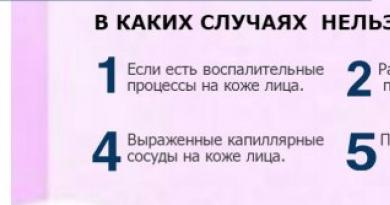The benefits of learning the alphabet in early age has been proven by many studies by psychologists, observations of educators and parents. Knowledge of letters is the basis for further successful development of reading, writing, speech and literacy development; in fact, this is the beginning of education.
And it is impossible to let this process take its course, hoping that the child will gain knowledge in kindergarten or school. However, it is best for a child to get acquainted with the alphabet in an easy way, game form. Therefore, below we will describe the main approaches and techniques to learning letters.
What age is optimal for learning the alphabet?
You can show your baby letters until he is one year old. Most likely, he will forget them if he does not return to them regularly. But even in this case, the information will be stored in the subconscious, and later the alphabet will be easier to remember. However, one year old child still other tasks. He actively cognizes the surroundings by taste and color, systematizes the external world in his mind, etc., and letters for him will be something abstract, increasing even more the chaos that appeared to his eyes after birth.
But 2-3 years is the age when a child can already understand and accept the alphabet. Perhaps sooner or later - after all, each baby is individual, and everyone’s development programs, abilities, and inclinations are different. Some people want to learn letters, while others are more interested in drawing dogs and cats... You also need to take into account different periods development in children. For example, from 3 to 4, a child’s motor activity actively develops and he is more interested in running and jumping than in reading. Therefore, you need to start mastering the alphabet unobtrusively, without pressure, from a few minutes a day. And the child should feel light and happy at this time. There is no need to rush if the baby does not want to study letters at all.
What time of day to choose to learn the alphabet
The time must be chosen so that the child is fresh and energetic. This doesn’t have to be in the morning - it can be in the evening after a nap, and there are children who are equally active almost all day. Much depends on the chosen study methodology. You can show your child letters during the day during games, reading, everyday activities... For example, folding them out of spaghetti, out of chestnuts while walking, finding them in inscriptions on clothes, etc.
Study methods
There are several methods for mastering the alphabet. Let us present the principles of some of them. Every parent decides what to choose based on their own sympathies and perceptions of the child. Some combine or take something as a basis and add their own inventions.
ABC
A mnemonic picture is attached to each letter: A - bus, B - bicycle... The method is good for memorizing the alphabet, but there is a risk that clear associations of letters with objects will be formed, and it will be difficult for the child to subsequently understand how from A-buses and M-bears it turns out to be “mother”.
Primer
Old classic way learning sounds and putting them into words. Here the processes of mastering letters, adding them into syllables of various combinations and into words occur in parallel. At the same time, the child sees eloquent illustrations of what he is adding.
The method is suitable for children after 5-6, when they have more perseverance. Primers are good for left-hemisphere children with a predominance of analytical thinking.
Montessori method
Based on the study of the alphabet in three sensory aspects: tactile, sound and visual. Those. the child touches the letter, hears its sound and sees the image at the same time. Rough letters and objects named on them are prepared for classes. First, the mother (or another teacher) takes out a letter, runs her index and middle fingers over it from top to bottom and calls it: “Here is the letter [y-y-y].” You can repeat the action several times, and then invite your child to do the same. When the baby has mastered this well, you need to take out the objects for the letters and show the baby, explaining that, say, a pear begins with [g]. This is how you need to work with your child every day, learning 3 letters and repeating those already covered.
To reinforce this, you can play with your baby. You need to prepare cards in advance with drawings of objects whose names begin with certain letters (“d” - house, tree, door...), sign them and put them in envelopes. To play, select a letter that has already been completed and invite the child to take out cards from the appropriate package, name the object and sound with which its name begins, and also circle the letter. If such a game seems difficult, try laying out the studied rough letters on the floor and asking your child to reach one or another of them on tiptoe (jump like a toad, crawl...).
Zaitsev's technique
We can’t help but mention the famous Zaitsev cubes. However, in pure form With this technique, children learn letters immediately, without studying letters separately, i.e. immediately learn to read. All possible combinations of letters are shown on the dice. The child first masters and remembers them, and then begins to put the syllables into words. There are both pros and cons to this. Subsequently, it can be difficult for the child to understand the structure of the word, and the child simply loses the opportunity to put two letters together on his own. Speech therapists also note swallowing of endings.
Zaitsev's cubes are suitable for right-hemisphere children with developed imaginative thinking and “lame” analytical thinking.
Polyakov's technique
Relatively new technique. First, vowels are studied in rhyming pairs “A-Z”, “U-Y”, etc. by repeatedly repeating and showing letters on cards, changing the order and composition of pairs. To do this, letters are written on cards (one card - one letter), and quickly shown to the baby with the sound “A-Z”, “O-Y”. In this case, the child should see only the letter in question. After several repetitions, you can ask the baby to name the letters. In the first lesson, two pairs of vowels are studied. On the second, these four letters are repeated, mastered in a non-rhymed form (A, O, Z, E) and a new pair is added, etc. Between lessons (held 2 times a week), 5 times a day you need to show the letters to the baby to reinforce them. Consonants are studied using 20 tables of 6 pairs of combinations. One consonant combines with hard and soft rhyming vowels, i.e.:
B-B-B
BA-BAH
BU-BU
etc.
Next you need to sing these pairs in a low and high voice. First, a pure sound is pronounced and repeated several times, then the warehouses. Tables are sung several times a day. In the first lesson, the child goes through 6 vowels and new ones are added as he masters them.
As a result, children learn pure sounds and their combinations.
How else can you learn letters?
It is better to start learning the alphabet with vowels, gradually introducing consonants and showing the child how they are combined. To do this, you can come up with the most different games. Hang cards with letters and tables around the house, in the morning stick a new letter to the window, telling the baby what the bird brought... To interest the child, you can offer to help him train his favorite toy, fashion an alphabet from dough, lay out a mosaic, accidentally find a ribbon in the shape of a letter etc. Children really like to stick magnetic letters on the walls of the bathtub while bathing.
What can you use to teach your child the alphabet?
Helpers in learning the alphabet can be cubes, magnets, coloring books, alphabet books... There are good educational cartoons, like “Lessons from Aunt Owl.” You can lay out letters from sticks and pencils, or sculpt them from plasticine and dough. Easels are very convenient, on which you can write the alphabet, warehouses, and attach magnets. There are also a lot of toys on sale that help with learning letters.
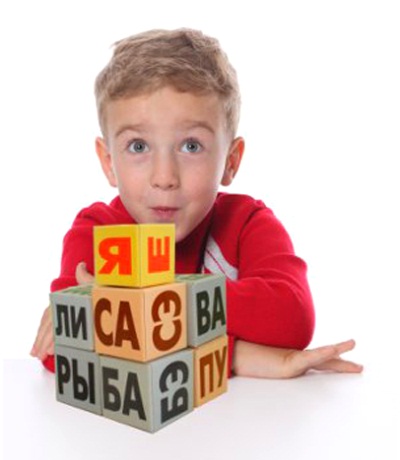
Whatever path you choose to learn the alphabet, the main thing is that the child accepts it. You also need to understand that without effort on the part of both the parents and the baby, it will not be possible to learn the letters.
There are a huge number of special techniques, starting with children's coloring books, in which the child colors various letters of the alphabet and studies them, and ending with online computer alphabet books loaded with programs on the IPade.
You can bake beautiful goodies in the form of letters. This is also a great way to introduce your child to the alphabet. The main thing here is not to overdo it, so as not to affect your health.
There is also method of teaching letters in strict sequence.
The author of this technique suggests that the child first learn 10 vowels, as he says, capital letters. These vowels go into rhyme and even remember them to a small child Shouldn't be too difficult.
These letters come in pairs like this: A - Z, O - E, U - Yu, Y - I, E - E.
The author of the method claims that in 5 lessons of 5-7 minutes you can learn all these vowels.
How exactly should you teach your child the alphabet?
Learning letters with your child - Home Economics program
Learning letters
The simplest thing is cut letters from A4 sheet and hang them in front of the child so that he gradually gets used to them. Visual memory is also involved in this process.
To begin with, you need to absolutely unobtrusively show him various letters of the alphabet.
The child should gradually get used to the letters. He needs to be explained what each letter is called.
Important! There shouldn't be any exams baby! There is no need to demand results at any cost! You need to try to teach the baby to remember letters in a playful way.
There is an opinion that the right approach learning letters is about memorizing sounds, not letters. That is, the sound itself “b”, “v” and so on is learned. And not “be”, “ve”.
What the letter itself looks like and what it is called is the second question. If you teach a child everything at once, there is a high probability that he will get confused and not understand anything at all.
Children remember letters very well if they are drawn in the form of an animal or bird. That is, they are associated with the image.
It will be good if a picture is drawn for each letter so that the child develops associative thinking. For example, A with a bus drawn on a card. B with a cherry also drawn and so on.
The first letters should be highlighted in red. The color red is known to attract the attention of children. This way they will be able to learn letters much faster.
Lessons from Aunt Owl - ABC, all letters
Learning the alphabet
Also, given the huge role game-based learning child, you can involve him in the process.
You can sculpt, for example, from plasticine, various letters. This will be very interesting for the baby, and will also connect motor memory.
 If you notice that your child loves various plants, tree leaves, or, for example, shells or pebbles that lie under his feet, then you can make letters out of them with him.
If you notice that your child loves various plants, tree leaves, or, for example, shells or pebbles that lie under his feet, then you can make letters out of them with him.
Another way to teach letters is with magnets.
Children love to play with magnets, and if they are made in the form of different letters, then this will also contribute to memorization.
It will be nice if you embroider in beautiful letters baby's name on his jacket or other clothes.
If he constantly sees these letters, he will probably learn them quickly.
It is very important to know that if you teach your child letters, then you need to teach them to write right away. This will greatly enhance the learning effect.
A very effective way to learn the alphabet is to sing it!
Learn a special song or melody and sing it often with your baby, and he will remember the alphabet unconsciously, along with the song.
When you have learned some letters, you can move on to the simplest words: pa-pa, ma-ma, and so on.
Alphabet song for kids
All parents sooner or later face the following problems: how to teach their child the alphabet, how to do it correctly so as not to discourage the child, and what methods are best to use.
Some children begin recognizing letters between ages 2 and 3 and can identify most letters by age 4. This means that you can start teaching your child the alphabet when he is about 3 years old. Of course, you shouldn’t expect your child to immediately remember many letters; this will take time.
Doctors and teachers believe that it is best to master letters after 3 years. From this age, children have increased curiosity and ability to learn.
But since each baby develops individually, parents must seize this moment. If you have problems with stuttering or pronouncing sounds, then it is better to wait.
There are several rules that will help you prepare for learning the alphabet:
- let the child choose the book you will read and turn the pages himself;
- carefully look at and discuss the pictures;
- Discuss what you read, let the child retell the story.
It is recommended to use methods that can attract the child's attention, since interest makes it easier to learn and remember. It is important to praise your baby and never scold him. Classes should be carried out at the same time, regularly, to develop a habit.
There are general instructions for learning letters in the alphabet:
Firstly, it is better to start learning letters from simple ones and those that are most often used, gradually moving on to rare and complex ones.
Secondly, one letter every couple of days will be enough for the baby. You can consolidate the result using cards with objects, letters cut out of paper or fabric, molded from plasticine. In order for a child to forget a previously learned letter, it is worth starting each lesson with repetition.
Thirdly, parents can tell the child what the letter looks like, read short poems about it, or sing a song.
Learning the alphabet at 3 years old
The first step in teaching the alphabet to a three-year-old is to get him interested. More often he begins to show interest in letters while reading. The task of mom and dad is to support this interest. By this age, the baby begins to have his favorite fairy tales and poems (if his parents read him a lot of books). Motivation appears to master the alphabet in order to read it yourself in the future. Children at the age of three remember best the first letter of their name, the letters A, B and C.
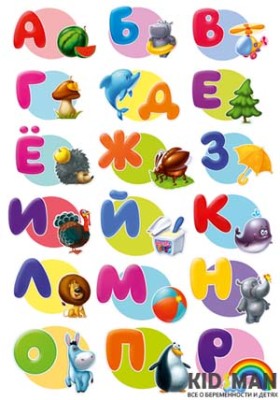
So, how to teach your child letters:
Firstly, you can use cubes with letters drawn on them, cards, magnetic alphabet, various posters and stickers.
Secondly, parents and their child must draw the letters on paper, on a board, or on the asphalt. This will help you remember the letters faster.
Thirdly, you can fold letters from various improvised materials, for example, buttons, sticks, and so on. This activity will be useful not only in terms of learning the alphabet, but will also help develop fine motor skills.
The main rule is that the alphabet is learned one letter at a time.
It is important to remember that a child of 3 years old should not be forced and forced to learn letters - this can discourage all interest and desire, and in the future it will be more difficult to teach the child letters.
Learning the alphabet at 4 years old
Classes for a four-year-old child are conducted in the same way as for a three-year-old child. Games are again used to teach letters. You can continue to form letters from objects.
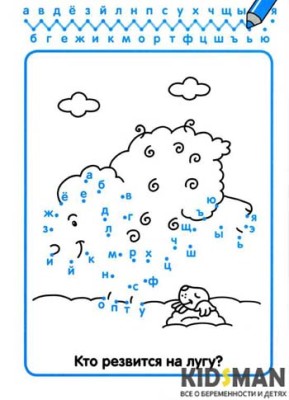
Parents should definitely include new games. These could be: “Magic bag”, “Find pictures”. First game: letters cut out of cardboard are put into a bag. The kid puts his hand there and, without looking, determines the chosen letter. Then he takes it out and checks whether he named it correctly.
In the second game they use a set of pictures with objects depicted on them and starting with different letters. 3-4 pictures and a certain letter of the alphabet are laid out, and the child looks for the depicted objects starting with it.
Learning the alphabet at 5 years old
At the age of 5 years, a child already consciously shows an interest in reading. He understands that words can be made from letters, and sentences can be made from words. A five-year-old child can independently, without parental prompting, use improvised objects to form letters and sculpt them from plasticine.
An electronic primer will be very useful at this age - it will interest and captivate the child. IN in this case It is very important to choose the right primer. Letters should be pronounced as the sounds that designate them (not “er”, but “r”, or not “en”, but “n”).
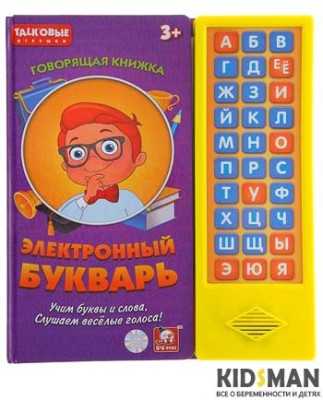
For four- and five-year-old children there is a special workbook “Learning Letters”, which they can use together with their parents or independently.
At this age, the main thing is that the child speaks correctly and coherently. To do this, parents should ask the child to tell something, for example, what he did today, let him retell his favorite fairy tale, and so on.
Learning the alphabet at 6 years old
6 years is the best period when a child can quickly memorize the alphabet and start reading. Therefore, parents should not worry too much if their baby has not previously shown any desire to learn letters. At 6 years old, a child can learn the alphabet much faster than at 3 years old.
In this case, for classes you can use primers, magnetic alphabet, and copybooks will be useful. You can watch special cartoons with your child that teach letters. Now there are many useful applications for tablets and smartphones, sites with educational games on the Internet that help a child learn the alphabet.
The whole family can create a custom ABC book. To do this, you need to draw or cut out of paper a letter and a picture depicting an object corresponding to this letter. Then we glue them onto a page in the sketchbook. The child will really like this work.
Consistent lessons using a primer help ensure that, in parallel with learning the alphabet, a six-year-old child learns to read.
So, the main rules for teaching a child letters:
- In order for a child to learn the alphabet, parents should not force them to study.
- The most favorable form of learning for learning letters is a game form of learning.
- It is worth starting classes when the child develops an interest in letters.
- The best way learn the alphabet - parents must arouse the baby’s curiosity.
- Worth choosing interesting games, which the child will sincerely want to play.
- If the child is not interested, he does not want to play with letters, then in this case the parents should postpone the lessons, because the child is not yet ready for this.
- It is very important to consolidate the learned material. Parents should ask the child to name the letters that are in surrounding objects. Let him draw them himself.
Now you have learned how to help your child learn the alphabet. Remember, you shouldn’t demand more from him than he can remember. And even if something doesn’t work out for him, don’t scold him. Pay attention to the child’s mood, whether he is tired. Your baby will be able to easily remember all the letters if you take into account the tips given in the article.
Perhaps the title of this article will seem immodest to you, and the author - arrogant. You might think that the author used such a title to attract the attention of readers.
Yes, that's true. The purpose of this title is to draw your attention to the truly most effective way to teach a child the letters of the Russian alphabet in the shortest possible time and teach him to pronounce these letters with sounds. You will see for yourself the simplicity and effectiveness of this method by reading this article and starting to teach your child letters with its help. After just five lessons, your child will know all 10 vowels well and will begin to memorize consonants, even if he did not know a single letter before. And, most importantly, he will learn letters during games and remember them firmly.
But first, a little digression. Before you start teaching your child letters, you must decide why he needs it. Some parents are proud that they were able to teach letters to a two-year-old or even one-and-a-half-year-old child. But you should only do this if you also start teaching your child to read. Any knowledge must immediately find its practical application. But teaching letters by itself, without simultaneously learning to read, makes no sense. There are many other, no less effective, ways to develop a child’s memory and stimulate the brain during its formation. It’s good if, by the time the child begins learning to read, he forgets these prematurely learned letters and does not begin to pronounce them the way he was once taught: Be, Ve, Ge... or By, You, Gy..., otherwise when reading this It will really bother him. You ask: “Well, if you teach a child letters and reading at the same time, then at what age is it better to start, from two years old?” I believe that at home, in the family, a mother with a child of this age can already study; but first for half a minute, and then for several minutes throughout the day. As a result of such “lessons”, built in the form of a game, the child will develop the ability to concentrate on some specific activity, and then, starting from the age of three and even a little earlier, he can be taught to read in a group of children like him. Just don’t forget that learning to read, especially early learning, should take place without coercion, in play, against a background of positive emotions.
A game method for learning ten vowels in 5 lessons
So, you have set out to teach your child to read books. You will, of course, start by learning letters with him. In what order should they be taught? Of course, not in alphabetical order and not in complete disorder, when the child is given vowels and consonants mixed up.
An important factor in the initial stage of learning to read in vocabulary is the child’s solid knowledge of the ten letters that represent vowel sounds (hereinafter, for simplicity, I will simply call them “vowels”). I have more than once drawn my attention to the fact that children who read poorly, even schoolchildren, are hesitant to name vowels, and when reading they stumble, remembering whether it is E, or Yo, or Yu. In view of the paramount importance of knowing ten vowels for full reading (so that the child does not “stumble” in every warehouse), I developed this game technique for them quick learning, which I have been successfully using for several years now.
The duration of each of the five lessons of this technique is several minutes. Lessons are held twice a week, and on the remaining days of the week, parents repeat the content of the previous lesson with the child for two to seven minutes a day. I calculated that teaching a child ten vowels using this method takes a total of just over an hour.
The methodology is based on the principle of repeated display and synchronous sounding of a group of symbols with their gradual partial replacement, proposed by the outstanding teacher Glen Doman. In this case, the task is made easier by the fact that in Russian the vowels form pairs that seem to rhyme: A - Z, O - E, U - Yu, Y - I, E - E. I supplemented the multiple screening with five reinforcing games I developed.
- The goal of classes using this method is to give the child a solid knowledge of ten vowels in five lessons. Often, parents believe that their child does not need this: “He has known all the letters since he was two years old.” When you start showing him the letters, it turns out that he doesn’t know them well. Confused E With Yo or with Yu, doesn't know E, Y, sometimes thinks, remembering a letter. Before starting to learn to read, the child’s knowledge of all vowels must be brought to automaticity.
- From other ways of learning letters, which often only slow down their assimilation and make it difficult to use ( A- watermelon, AND- turkey or ABOUT- like a bagel, Yu- Yulina letter, I- looks like a pole with a lantern, etc.), this technique is simple and effective.
Lesson #1
Write or print the vowel letters on thick white paper, each on a separate card: letters A, O, U, Y, E- in large bold red font on cards measuring 12x10cm, and I, Yo, Yu, I, E- in blue bold font of a slightly smaller size on 9x10cm cards. For the first lesson you will only need cards A, Z, O, Yo.
| A | I |
| ABOUT | Yo |
On the back of each card, write this letter by hand for yourself, so as not to look at the front side when showing the letters to your child.
Classes can be taught by a teacher or one of the child’s parents.
Showing the first two pairs of vowels (A - Z, O - E).
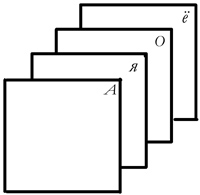
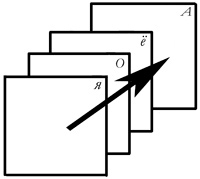
Place two pairs of cards in a stack as shown in the left picture, with the back side facing you. Move the card closest to you A forward (as indicated by the arrow in the right picture) and show it to the child. Say: "This is A". Then put the next card forward and say: "This is I"; then - "This is - ABOUT"; and then - "This is - Yo"Show each card no longer than 1 second. Do it in a fun way, like a game. Look not at the cards, but into the child’s eyes to see where he is looking and attract his attention. Letters A And ABOUT most children already know. You can pause and give the child the opportunity to name them himself. A letters I And Yo quickly call it yourself, before the child so as not to give him the opportunity to make a mistake. And don't ask your child to repeat them. Your task is to quickly show these four letters and at the same time recite a small poem:
"This - A"
"This - I"
"This - ABOUT"
"This - Yo"
Children can easily remember longer poems, and even more so, they will soon begin to repeat such an easy poem on their own.
If you are a teacher, explain to the child's mother present in class that she must show and name these four letters to him every day until the next lesson at least five times a day. Let her do this the first time in your presence so that you can correct her if she does something wrong. Do not hesitate to explain everything to parents in the same detail as to their children and check that they understand you. Shuffle the cards. Ask mom to put them in the right order. Then she must sit or stand the child in front of her and look into his eyes while showing the letters. She must pronounce letters unfamiliar to the child clearly and before him. A typical mistake is when mom takes out the next letter and holds it in her other hand, without covering the last letter with it. In this case, the child sees two letters at the same time.
Tell your mom that all the homework will take her half a minute a day, because... one such display lasts five seconds. It’s just important not to miss them. Gradually, the pause after the word “This is...” should be increased, and the word itself should be pronounced with a questioning intonation, as if encouraging the child to name the letters himself. The child must simply name the letter. He shouldn't say "this" A" or "letter A"Give your mother the four letters you made and ask her to bring them with her to class.
Lesson #2
By the beginning of this lesson, the children had already repeated for two or three days after their mother A, Z, O, Yo and remembered them well in this order.
Reinforcing games.
Now with these four letters you need to play five reinforcing games so that the children firmly remember them both in the order of the learned rhyme and separately.
Place four cards in pairs on the table in front of the child, calling them out loud, in the order in which they were shown to him. After that, start playing games.
| A | I |
| ABOUT | Yo |
1st game. "Wind". Explain to your child that the red letters are big brothers, and the blue letters are little brothers. Then say: “The wind came and mixed up all the brothers.” Mix the letters yourself so they don't end up upside down. Then let the child put them in order in pairs, calling out loud: A- near I, ABOUT- near Yo(with your help at first).
2nd game. "Hide and seek." Cover the smaller cards with larger ones (red letters on top) and change the order of these pairs: “The little brothers hid under the big ones and swapped places so that Helen wouldn’t find them. Guess which little brother hid under the big brother ABOUT? That's right, under ABOUT hid Yo! And under A? Right, I!"
Game 3 "Hide and seek." You play the same way, but this time it’s the other way around - the big brothers are hiding under the little ones.
4th game. "Crow". Move your palms over the cards laid out in the correct order and say: “The crow flew, flew, flew, flew and... ate the letter.” Quickly cover one of the letters with your palm: “Which letter did the crow eat?” It is better to move both palms at the same time, so that it is more difficult for the child to guess which letter you are going to cover. If he was unable to answer quickly, remove your palm for a moment and cover the letter again. If he doesn’t say even then, tell me, for example: “Next to ABOUT. Right, Yo!" Over time, the child will remember the location of the letters and will guess them easily.
Game 5 "Cards". Now use the same cards to play with your child the same way adults play cards. You shuffle the cards, then throw a card on the table in front of him and ask: “What is this?” If you name it correctly - you win and take the card, if you make a mistake - another student takes it, and at home - your mother takes it. Don’t rush to allow other students to give you hints, let your child think a little. At first, try throwing cards in pairs: first ABOUT, behind her Yo, A — I etc. If the child wins confidently, throw in pairs, but in reverse order. Then start throwing randomly.
The mother present at the lesson remembers and writes down how to play these five games at home. You only need to play once a day, unless the child asks for more. But each time, stop the game while he still wants to play: “We’ll finish the game another time.”
Showing three pairs of vowels (A - Z, O - Yo, U - Yu).
After you have played five games with the first two pairs of letters, draw the next pair of cards you made U - Yu, write them on the back for yourself and add them to the pile (after the lesson, give this pile, all six letters, to your mother).
| A | I |
| ABOUT | Yo |
| U | Yu |
Now show your child three pairs of letters the same way you showed him two pairs in lesson No. 1. Only this time the child names the first four letters, and you quickly name the last two yourself, not letting him make a mistake (remind your mother of this too). Give mom the same instructions as in lesson No. 1. By the next lesson, after two or three days of showing, the child will remember a new poem:
"This - A"
"This - I"
"This - ABOUT"
"This - Yo"
"This - U"
"This - Yu"
Give your mom these six letters you made and ask her to bring them with her to the next lesson.
Attention! After lesson No. 2, the mother shows the child these three pairs of vowels several times a day, but so far plays reinforcement games with him only for the first two pairs ( A - Z, O - E) once a day.
Lesson #3
By the beginning of this lesson, the children had already learned the rhyme:
"This - A"
"This - I"
"This - ABOUT"
"This - Yo"
"This - U"
"This - Yu",
and the letters A, Z, O, Yo thanks to five reinforcing games they know and randomly. Now they need to consolidate the knowledge of the last vowels they learned U And Yu.
Reinforcing games.
Place the following six cards in pairs on the table in front of your child, calling them out loud, in the order in which they were shown to him. After this, play the games detailed in Lesson No. 2.
Show your child these three pairs of letters as you did in previous lessons. As before, the child names the first four letters, and you quickly name the last two yourself, not letting him make a mistake (remind your mother of this too).
Give your mom all the letters you made and ask her to bring them with her to the next lesson. Tell your mom that all her homework will now take her no more than six minutes a day and remind her that it is important not to miss any of them.
Attention! Pay attention to the mother that after this lesson the child needs to be shown these three pairs of vowels several times a day, putting aside those that are well known to him A - Z. And in the evening you need to play reinforcement games with him once only for the first three pairs: A - Z, O - Yo, U - Yu(without yet Y,— AND).
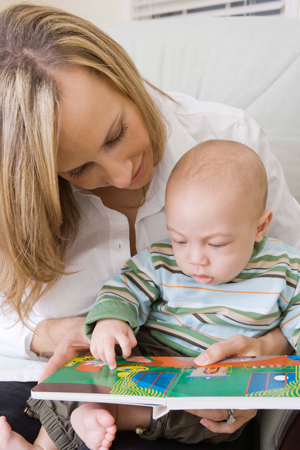
Lesson #4
By the beginning of the fourth lesson, children know the following vowels in pairs: A - Z, O - E, U - Yu, Y - I, and the letters A, Z, O, E, U, Yu Thanks to reinforcing games, they know randomly. Now they need to consolidate the knowledge of the last vowels they learned Y And AND.
Reinforcing games.
You have already realized that the number of vowels with which we play reinforcement games increases with each lesson: in the second lesson we played with four letters, in the third - with six, and now these five games need to be played with eight letters.
Place the following eight cards in pairs on the table in front of your child, calling them out loud, in the order in which they were shown to him. After this, play the games detailed in Lesson No. 2.
| A | I |
| ABOUT | Yo |
| U | Yu |
| Y | AND |
Showing three pairs of vowels (U - Yu, Y - I, E - E).
This time you remove the first two pairs of cards A - Z And O - Yo, and take out the last pair you made E - E. Label these cards on the back for yourself and add them to the pile. The total number of letters shown is still six and the rhyme remains just as easy to remember. It is also important that the letters E And Yo, which children often confuse, never “meet” when shown: when the letter “came” E in the fourth lesson, letter Yo has already "gone". Now the cards are in the pile in the following order.
| U | Yu |
| Y | AND |
| E | E |
Show your child these three pairs of letters as you did in previous lessons. As before, the child names the first four letters, and new ones for him E And E you quickly call yourself, not letting him make a mistake ( once again remind your mother about this too). Give your mom all ten letters you made and ask her to bring them with her to class. Tell her that all her homework will now take her no more than six to seven minutes a day and remind her that it is important not to miss a single one.
Attention! Please pay attention to the mother that after this lesson the child needs to be shown the last three pairs of vowels several times a day, setting aside the ones that are well known to him. A - Z And O - Yo. And in the evening you need to play reinforcement games with him once for the first four pairs: A - Z, O - E, U - Yu, Y - I(without yet E, E).
Sergey Polyakov
Author's article
Lessons German alphabet- this is children learning each of the 26 letters with pleasure, in a playful way, accompanied by bright cartoons that they love so much! Part 1. Polyakov Sergey. Learning letters - Polyakov's game method.
And one more thing - is his method suitable for teaching non-Cyrillic alphabet? The fact is that we are not learning the Cyrillic alphabet, but the Latin alphabet, or rather the Estonian alphabet. The best way to learn letters. Part 1. You will begin, of course, by learning letters with him.
Discussion
I don’t agree that for three year old child It is better to stick to the traditional method of teaching reading. It is still intended for older children.
For your age, you need to start reading not by reading, but by writing. Not with a pen, of course. :) With a pointer using Zaitsev’s warehouse tables, his cubes, syllable cards he made with his own hands, and finally. The danger of overload is practically eliminated here; there is no internal tension, which often occurs when learning to read directly, the child feels free.
I'll explain. The logic is simple. Building it yourself (writing) is much easier and more productive than actually trying to interpret mergers, etc. And since writing and reading are mirror processes, children gradually gradually move on to reading.
We write our own and read someone else’s.
Is reading the mergers “OS”, “SO”, “MU”, “UM” interesting for a three-year-old? even for a five-year-old...:(In principle, all the primers are not created for children (there is nothing interesting in them for children), but for the convenience of teaching adults.
Writing and then reading what the child himself wants, what is close to him, means studying according to his own program, and not according to an imposed one.
My many years of experience working with preschoolers speaks to the correctness of this path.
If you are interested in this path, I am ready to help with specific advice. It’s easier to find me in the conference “Children from 3 to 7 years old”.
It is possible to teach a child to read at this age. It is better to adhere to the traditional method of teaching reading (not Zaitsev’s method). the basic principle is from sound to letter, i.e. letters (especially consonants) should be named as they sound like S, not se, etc.
The biggest problem for you at the first stage will be the merging of letters (in this case, sounds) into syllables, since at this age the process of synthesis (combination) is still poorly developed in children; in the traditional program, this process is developed first by ear, and then they begin to read . but in fact, visibility only helps the child.
to make it easy, start with vowels only
1. vowel fusion
they are easy to sing, you can sing each letter loudly with your child, this will give him pleasure. AAUUU - smoothly move from one letter to another. be sure to ask what happened, what song
2. fusion vowel-consonant OS, UM
3. merging consonant-vowel SU, etc.
to begin with, take moguls that can be stretched - sss, zzzz, fff, shhh, etc.
when reading a syllable, do not break it up in this way - ba - be and and this is ba, for a child this will not be clear, because he hears beia, or bea. you complicate the learning process
Another important principle is to offer everything in a playful form - write the syllables yourself, use toys
and remember that for most kids, new things are not always easy to learn, so at first just invite him to watch you play. maybe even more than one activity.
don’t demand results from your child, don’t force him, offer bright, cheerful letters
do not be alarmed if the child suddenly refuses, he will not forget your game and after a while he will ask you to repeat it himself.
I bought Ksyushka "Alik. My first English alphabet." With Alik there is also preparation for school and something else, the series is like that. There you have to look for letters in the picture, examples of words are given for each letter, and there are also games, such as arranging the letters in the alphabet (stringing beads), “pairs” with letters, etc. I saw it on Gorbushka.
We started by studying the alphabet, counting, animals, flowers, and household items. From the first grade, they taught him using some kind of experimental method: the children were taught to read the whole year not in I was exposed in a playful way - a lot of interesting things can be invented. Write the alphabet.
Discussion
From first grade we have 7 English lessons per week, i.e. 3 days of 2 lessons and 1 day - 1 lesson, no English on Friday. The program is special, based on textbooks from England. We started by studying the alphabet, counting, animals, flowers, and household items. But this is all mixed up with the letter or sound that is being taught right now. In 2nd grade, grammar and spelling were added, rules are taught with examples. Along the way vocabulary replenished, they learn 20-30 words in 1-2 weeks. They also read texts, retell them, learn dialogues, and a lot more...
09.23.2002 10:12:12, SelaI'm afraid that my personal serious study of English began in the first grade. language school, with 6 such (or similar) lessons per week. In other words, there was English every day. The teacher was an old lady who had studied at the Helsingfors Gymnasium as a child! I didn’t believe in any “methods” in principle. She taught phonetics in monotonous repetitions with a mirror, we chanted tables of incoherent words in chorus, and about reading English words, she once and for all drove the concept into my subconscious - every English word must be learned by heart along with pronunciation! Because there are no rules.
Nothing, two years of satrap’s methods didn’t even affect my psyche. Because she differed favorably from the average Soviet school teacher in her human behavior. Unfortunately, two years later I transferred to a completely different school, also English. But the foundations of the language were laid precisely in those two years - then only the investigation.
Details
What is the fastest way to learn letters with your child? The easiest way is to hang a poster with the alphabet on the wall and regularly voice it to your child... But... this method does not work for all children! Unfortunately, many children get bored very quickly and simply “run away” from such activities.
If you find yourself in such a situation, don’t despair! There are many fun games to learn letters that your child will definitely love!
Before you start learning letters, it is important not to forget:
Most preschool teachers agree that it is best to teach children the “sound” interpretation of letters (not “Ka” but “K”, not “Be”, but “B”, etc.).
This is done so that later it will be much easier for the child to learn to add syllables.
Compare in which case it will be easier for a child to “figure out” how to form a syllable:
Sound option: “B” + “A” = “BA”
Letter version: “Be” + “A” = ?????- p about the logic of things, children often want to say “BeA” at this point, and this is where it arisesthe main problem that many parents face when teaching their children “classic” letter names(such as “Be” “Ve”, etc.) – when reading syllables, it is difficult for a child to mentally reject the sound “a” from “Ka”, the sound “e” from “Ve”, etc. (they want to read not “VA”, but “VEA”, not “BU”, but “BeU”, etc.)
And this complexity becomes a serious obstacle to teaching a child the skill of combining individual letters into syllables.
Therefore, studying the “sound” interpretation of letters will be much preferable.
“Learning letters is fun!” - educational games for non-boring children!
1. Coloring.
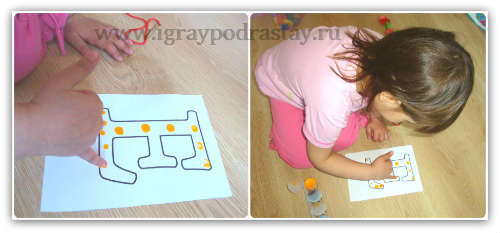
Everything is simple here! You can download coloring pages with letters from the Internet and invite your child to color them. The child will engage in creativity with interest, and at the same time consolidate knowledge about the new letter.
To prevent the child from getting bored with the coloring process, you need to use various interesting techniques:
Color letters not only with pencils, but also with paints, wax crayons, and stamps;
Paint with your fingers using finger paints;
Use unconventional techniques drawing ( cotton swabs, crumpled paper, blots etc.).
2. Decorate the letter.
Children will have fun decorating the letters!
You can decorate them with plasticine, applique, colored glass, construction kit parts... whatever you want!
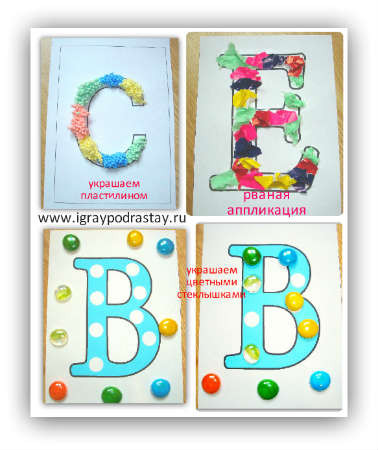
Try decorating the letter “A” with watermelons, the letter “B” with bananas, etc.
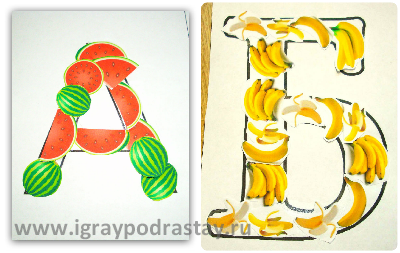
3. We sculpt.
A very useful activity is to sculpt letters from colored dough or plasticine. And if you combine sculpting with listening to songs by Ekaterina Zheleznova from the album “Musical ABC Book” (in which the whole process of sculpting is “sung” in a very interesting way) - then sculpting will be even more fun.
Wonderful mothers, passionate about the development of children, have long made funny videos from these songs and posted them online.
For example, while playing and watching a funny video, you can make the letter A in a fun and interesting way:
Tilt two sticks
Connect at the top
One crossbar -
Like a letter A tent!
4. Halves - a game to consolidate knowledge about already familiar letters.
In the process of learning the alphabet, the process of repetition is important. Of course! After all, by the time you get to “I”, you must try not to forget the letter “A”.
The process of repeating already learned material will be more fun with the game “Halves”!
Cut out beautiful cards with letters, cut them into two parts, mix them.
Invite your child to “fold” letters from two halves.
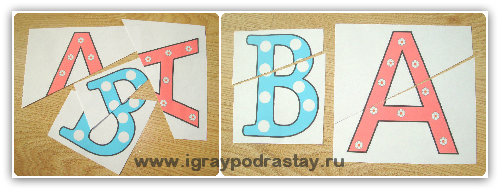
5. Memory.
To consolidate the material covered, the well-known game “Memory” is also suitable (at the same time, attention and memory are trained). You will need a set of cards in which each of the pictures with a certain letter is presented in duplicate.
Shuffle the cards and place them in front of the child, white side up.
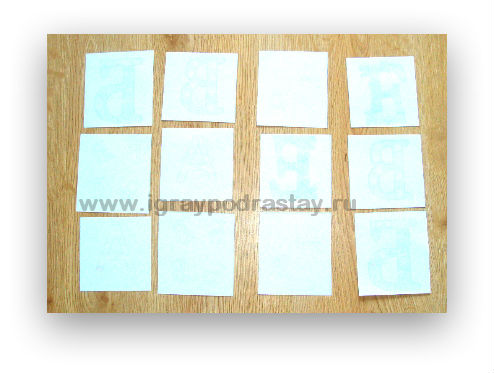
Ask him to turn over any of the cards, name the sound that the open letter represents. Then the player needs to find exactly the same card among the others that have not yet been turned over. The player looks for the desired letter by turning over the remaining cards and checking what is written on them.
Did you open the wrong letter? Turn it back to the white side up and look for a pair further!
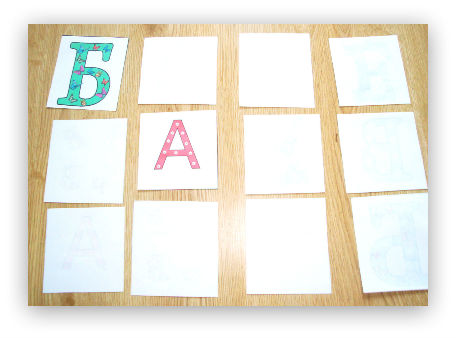
When the required card is found, the player takes two cards for himself and the game continues until a pair is found for each card.
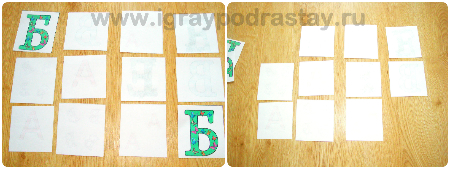
6. We write on semolina.
Children love to draw on semolina! Without exception, everything – from small to large! Even if your child is already 10 years old and seems “so big” already, believe me, he will be delighted with drawing on semolina!
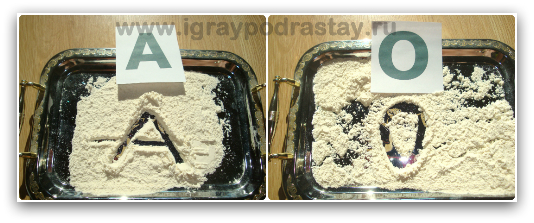
7. Lotto and foil.
Another way to study and repeat letters is lotto.
Not all children are enthusiastic about letter lotto. In order to interest the child in this game, you can use foil or paper.
Prepare the playing field, and also wrap the letter figures in foil or paper.
Invite your child to unfold the letter and place it in its place on the lotto playing field.
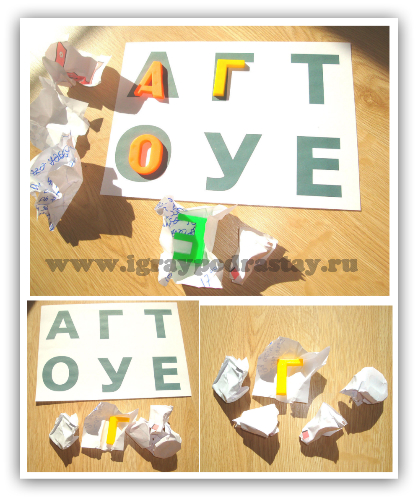
Lotto can be sound - in this case you need to put a letter on a card on which an object is drawn that begins with this letter.
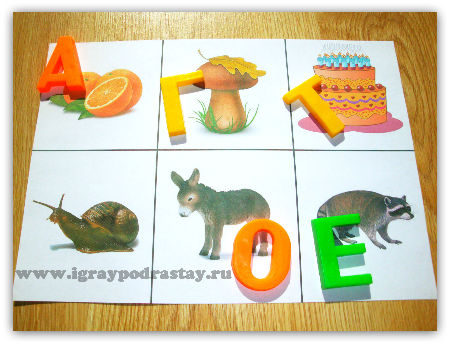
8. Letter eater.
A cheerful Bukvoeshka may appear in your home. The easiest way to do this is to take a glove doll or a soft toy.
For example, this cockerel -
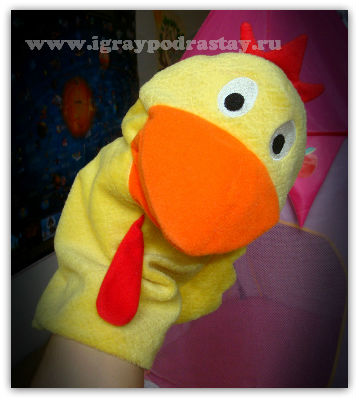
very unusual! He eats letters! Come on! Let him eat the letter B! And now he wants the letter A! Oh, how deliciously you feed the cockerel!
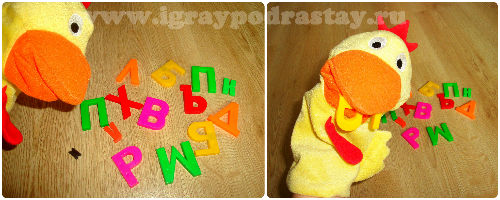
You can play the letter game in another way:
Funny people live in this box. They eat nothing but letters. Let's feed them? (the little people's mouths are the slits in the box).
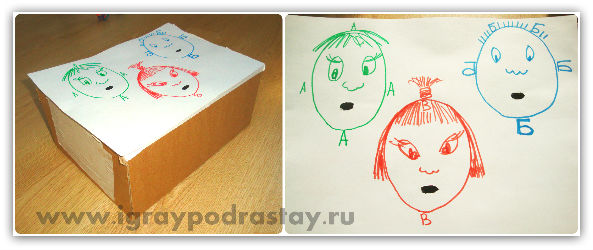
Here is their food (we draw letters on the beans with a felt-tip pen):
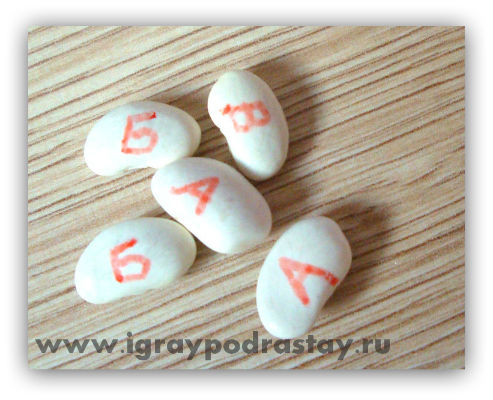
We feed the little men (each little man has his own letter, if the baby makes a mistake, the little men spit merrily, close their mouths and demand to be fed with another food that suits them better (beans with “their” letter):
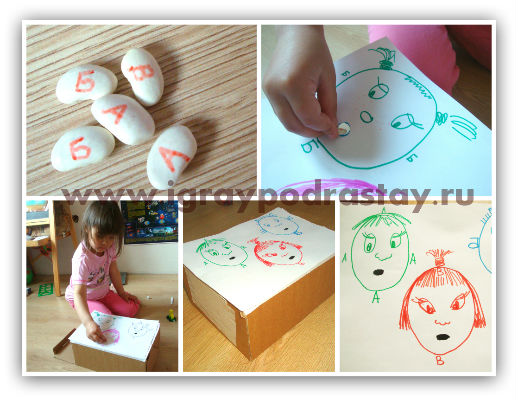
9. We design.
We lay out silhouettes of letters from counting sticks, matches, Lego and everything else that comes to hand:
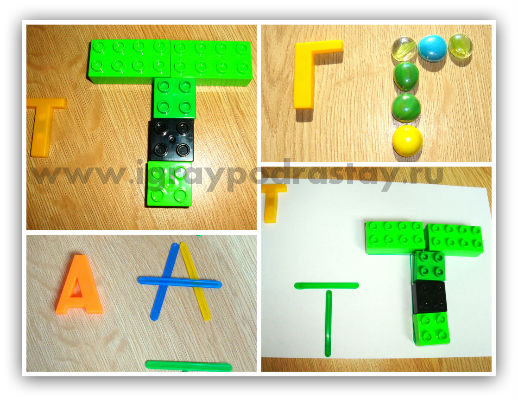
Some children may find it difficult to form letters from available materials (especially if the child is under 3.5 years old).
With such children you can design using the “overlay” method.
To do this, you can draw these simple diagrams:
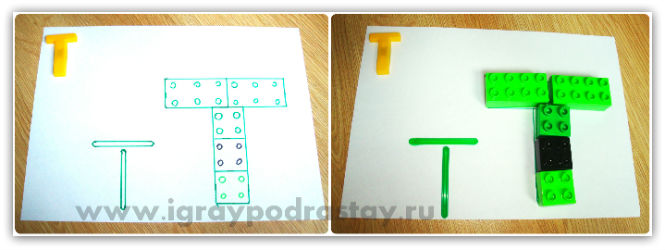
Also, in order to build letters, you can use the Zheleznovs’ musical primer, which was already written about in paragraph 3 of this article.
For example, poetry and a song, which is described in paragraph 3 for "A" can also be used to construct this letter from sticks (Tilt two sticks, connect them at the top, one crossbar - like a letter A tent!)



